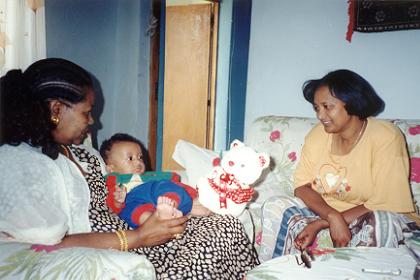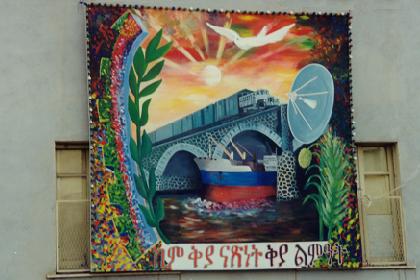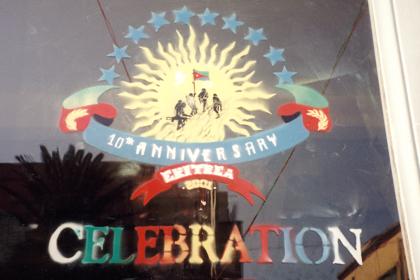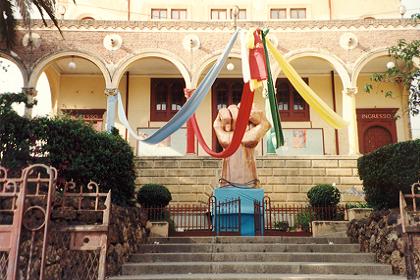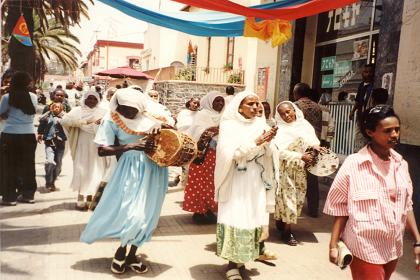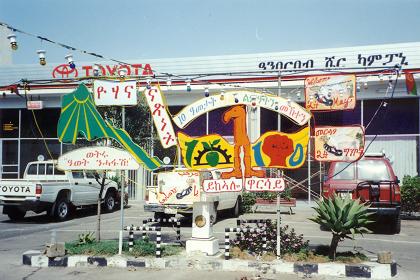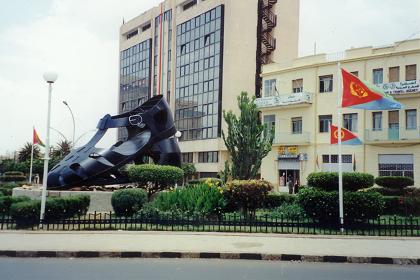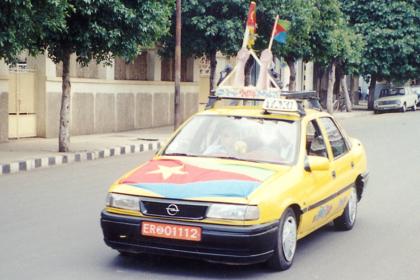| Eritrea May 2001 | ||||||
| Mon | Tue | Wed | Thu | Fri | Sat | Sun |
| 01 | 02 | 03 | 04 | 05 | 06 | |
| 07 | 08 | 09 | 10 | 11 | 12 | 13 |
| 14 | 15 | 16 | 17 | 18 | 19 | 20 |
| 21 | 22 | 23 | 24 | 25 | 26 | 27 |
| 28 | 29 | 30 | 31 | |||
| Eritrea June 2001 | ||||||
| Mon | Tue | Wed | Thu | Fri | Sat | Sun |
| 01 | 02 | 03 | ||||
| 04 | 05 | 06 | 07 | 08 | 09 | 10 |
| 11 | 12 | 13 | 14 | 15 | 16 | 17 |
| 18 | 19 | 20 | 21 | 22 | 23 | 24 |
| 25 | 26 | 27 | 28 | 29 | 30 | |
| next page | previous | |||||
| Celebrating 10 years liberation | ||||||
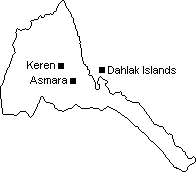 |
||||||
Asmara May 25th 2001
Today we visit Terhas. I bought her a singing bear for the 3 months old baby. I still can't get used to the idea that it is best to give money. There must have been an envelope for her from her family in Holland. It is the same every year. When they know Mebrat and I are going to Eritrea, the envelopes for the various relatives in Eritrea are entrusted to us. Not only are the costs of the money transfers very high, I have been told that there is a good chance to money will end up somewhere in Addis Abeba, as a result of never updated banking procedures.
It is still early and there is plenty of plans, but most offices are closed because of the celebrations. At the post-office, when buying the stamps issued for the 10th anniversary of Eritrean independence, I suddenly hear a lady speaking Dutch. It is Marijke Nijhuis from Enschede. She volunteers for Child Care Afrika and is in Eritrea to monitor the support to an orphanage in Dekemhare. They still need a lot of things (and money).
Before I left to Eritrea I asked my colleagues to work one hour for Eritrea. The result was $350. I tell Marijke that her foundation is the first to share if there is any money left (There is. Raising money is one thing. Trying to find institutions to spend it is another).
Only two hours later I see a very beautiful Eritrean girl. She tells me she is Elsa Woldu from Germany. She is a nurse and she is supporting Orphans homes in Eritrea. She raised 500.000 DM. I used to tell my colleagues that giving small amounts also count in a country where everyone is poor. But compared to what Elsa have achieved, everything else looks like nothing.
Walking down Martyrs Avenue I see a giant sandal (Shida) that is unveiled yesterday. This little sandal played an important role in the 30 year struggle for independence. "It is the shoes that lead us to our victory", one of the locals tells me. "While the Ethiopians got tired, walking many miles in their heavy boots, getting perspiring feet, our fighters had the power of endurance and mobility in their airy sandals. And when they went to pieces, they were repaired by just melting the pieces together with a cigarette lighter or a piece of iron heated in a fire."
Eritrean television is interviewing a reporter at the monument. Three children on the other side of the street are singing songs. The television team, hindered by the unwelcome background vocals is scaring them off. I take the children to the other side of the block and ask them to sing for my video camera. The do their best to make it a beautiful show.
Visiting Terhas and her baby in Asmara.
Decorations on the wall of the Ministry of Transport and Communications.
Decorated shop-window in Asmara celebrating the 10th anniversary.
Making a fist to the Shifta Woyane - Cinema Asmara - Harnet Avenue.
Woman singing and making music on the streets of Asmara.
Decorations in front of the Toyota Garage in Asmara.
Shida Square: a roundabout with a construction of two giant sandals.
The monument was unveiled on the occasion of the 10th anniversary of
independence. "shida" is the Arabic word for sandals. The footwear, made
of sheet metal and extending more than 20 feet long, lies in a small park.The shida is far more than a cheap, plastic sandal in the Eritrean psyche.
It is the footwear that EPLF fighters wore in their 30 years struggle to
liberate their country. They were inexpensive, easy to repair by melting
the material together, and allowed air to circulate around the feet. It was
part of the EPLF uniform and now a symbol of Eritrean independence.
The sculpture was the idea of Eritros Abraham who returned to Eritrea
in 1991 from 20 years of exile in the United States.
Taxi driver celebrating 10 years liberated Eritrea - Asmara.
